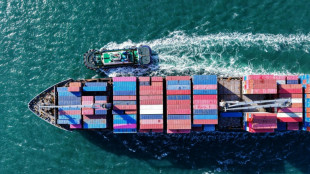
-
 Japan says US tariffs 'extremely regrettable', may break WTO rules
Japan says US tariffs 'extremely regrettable', may break WTO rules
-
South Koreans anxious, angry as court to rule on impeached president

-
 Juve at in-form Roma with Champions League in the balance
Juve at in-form Roma with Champions League in the balance
-
Injuries put undermanned Bayern's title bid to the test

-
 Ovechkin scores 892nd goal -- three away from Gretzky's NHL record
Ovechkin scores 892nd goal -- three away from Gretzky's NHL record
-
Australian former rugby star Petaia signs for NFL's Chargers

-
 China says opposes new US tariffs, vows 'countermeasures'
China says opposes new US tariffs, vows 'countermeasures'
-
Athletics world watching as 'Grand Slam Track' prepares for launch

-
 Heat humble Celtics for sixth straight win, Cavs top Knicks
Heat humble Celtics for sixth straight win, Cavs top Knicks
-
Quake-hit Myanmar's junta chief to head to Bangkok summit

-
 New Spielberg, Nolan films teased at CinemaCon
New Spielberg, Nolan films teased at CinemaCon
-
Shaken NATO allies to meet Trump's top diplomat

-
 Israel's Netanyahu arrives in Hungary, defying ICC warrant
Israel's Netanyahu arrives in Hungary, defying ICC warrant
-
Shiny and deadly, unexploded munitions a threat to Gaza children

-
 Stocks tank, havens rally as Trump tariffs fan trade war
Stocks tank, havens rally as Trump tariffs fan trade war
-
Altomare hangs on to tie defending champ Korda at LPGA Match Play

-
 Paraguay gold rush leaves tea producers bitter
Paraguay gold rush leaves tea producers bitter
-
Health concerns swirl as Bolivian city drowns in rubbish

-
 Syria says deadly Israeli strikes a 'blatant violation'
Syria says deadly Israeli strikes a 'blatant violation'
-
Financial markets tumble after Trump tariff announcement

-
 Starbucks faces new hot spill lawsuits weeks after $50mn ruling
Starbucks faces new hot spill lawsuits weeks after $50mn ruling
-
Europe riled, but plans cool-headed response to Trump's tariffs

-
 'Shenmue' voted most influential video game ever in UK poll
'Shenmue' voted most influential video game ever in UK poll
-
New coal capacity hit 20-year low in 2024: report

-
 Revealed: Why monkeys are better at yodelling than humans
Revealed: Why monkeys are better at yodelling than humans
-
Key details on Trump's market-shaking tariffs

-
 'A little tough love': Top quotes from Trump tariff talk
'A little tough love': Top quotes from Trump tariff talk
-
US business groups voice dismay at Trump's new tariffs

-
 Grealish dedicates Man City goal to late brother
Grealish dedicates Man City goal to late brother
-
US tariffs take aim everywhere, including uninhabited islands

-
 Trump sparks trade war with sweeping global tariffs
Trump sparks trade war with sweeping global tariffs
-
Israeli strikes hit Damascus, central Syria; monitor says 4 dead

-
 Slot 'hates' offside rule that gave Liverpool win over Everton
Slot 'hates' offside rule that gave Liverpool win over Everton
-
US stocks end up, but volatility ahead after latest Trump tariffs

-
 Barca oust Atletico to set up Clasico Copa del Rey final
Barca oust Atletico to set up Clasico Copa del Rey final
-
Mourinho grabs Galatasaray coach's face after losing Istanbul derby

-
 Grealish strikes early as Man City move up to fourth in Premier League
Grealish strikes early as Man City move up to fourth in Premier League
-
Reims edge out fourth-tier Cannes to set up PSG French Cup final

-
 Liverpool beat Everton as title looms, Man City win without Haaland
Liverpool beat Everton as title looms, Man City win without Haaland
-
Jota wins bad-tempered derby as Liverpool move 12 points clear

-
 Inter and Milan level in derby Italian Cup semi
Inter and Milan level in derby Italian Cup semi
-
Stuttgart beat Leipzig to reach German Cup final

-
 Trump unveils sweeping global tariffs
Trump unveils sweeping global tariffs
-
Italian director Nanni Moretti in hospital after heart attack: media

-
 LIV Golf stars playing at Doral with Masters on their minds
LIV Golf stars playing at Doral with Masters on their minds
-
Trump unveils sweeping 'Liberation Day' tariffs

-
 Most deadly 2024 hurricane names retired from use: UN agency
Most deadly 2024 hurricane names retired from use: UN agency
-
Boeing chief reports progress to Senate panel after 'serious missteps'

-
 Is Musk's political career descending to Earth?
Is Musk's political career descending to Earth?
-
On Mexico-US border, Trump's 'Liberation Day' brings fears for future


Modern phoenix: The bird brought back from extinction in Japan
Every day for the past 14 years, 72-year-old Masaoki Tsuchiya has set out before sunrise to search for a bird rescued from extinction in Japan.
Starting his car under star-dotted skies unpolluted by light, he works alone in the pre-dawn chill, marking sightings or absences in a planner, interrupted only by the crackle of a walkie-talkie.
The bird he is looking for is called "toki" in Japanese, and its presence on his home of Sado island is testament to a remarkable conservation programme.
In just under two decades, Japan's population of wild toki has gone from zero to nearly 500, all on Sado, where the bird's delicate pink plumage and distinctive curved beak now draw tourists.
It's a rare conservation success story when one in eight bird species globally are threatened with extinction, and involved international diplomacy and an agricultural revolution on a small island off Japan's west coast.
- A cautionary tale -
Tsuchiya, stocky and spry with an impish grin, doesn't eat breakfast until he has made all his stops, and after years of practice he can spot chicks hidden in nests through the monocular attached to his rolled-down car window.
He points to virtually imperceptible marks on a road or a wall that help him remember where to park and start surveying.
"The number I see at this spot depends on the season," he explains.
Some days dozens of the birds appear in one area, something unimaginable in 2003, when a toki called Kin or "gold" died in a cage on Sado at the record-breaking age of 36.
Her death meant not a single wild-born toki was left in Japan, despite the bird being so synonymous with the country that it is also known as the Japanese crested ibis.
"I knew the day was coming. She was very old and frail," Tsuchiya said. "But it was still a real pity."
Efforts to get Kin to mate with Sado's last wild-born male toki Midori -- meaning "green" -- had long since failed, and she lived out her last years as a curiosity and a cautionary environmental tale.
Her death made national headlines and appeared to mark the end of a long and seemingly futile battle to protect the toki in Japan, where its feathers even inspire the word for peach pink: "toki-iro".
But now so many roam the skies and rice paddies of Sado that local officials have gone from discouraging eager birdwatchers to training guides to help visitors spot the local icon, and the government is even studying reintroducing the bird elsewhere.
- Wiped out -
Wild toki once lived across Japan, as well as in Russia, Taiwan and South Korea.
They were considered a pest that damaged rice plants, but during Japan's Edo era, from 1603 to 1867, hunting restrictions meant only high-ranking officials could actively pursue birds like toki.
That changed in the Meiji era and as guns became more available. Toki meat was believed to have health benefits, and its feathers were favoured for everything from dusters to decorative flourishes on hats.
"Over just 40 years, the toki basically disappeared," said Tsuchiya on an observation deck where visitors now try to spot the bird.
By the early 1930s, only a few dozen toki remained in Japan, mostly on Sado and the nearby Noto peninsula, and the species won protected status.
A fresh threat then emerged during Japan's post-war drive for growth: rising use of chemical fertilisers and pesticides.
Toki feed primarily in rice paddies that mimic marshy wetland habitats and they are undiscriminating diners, eating everything from insects to small crabs and frogs.
The chemicals affected the birds and their food, and by 1981 just five wild toki remained in Japan, all on Sado, where officials took them into protective captivity.
But by bizarre coincidence, the same year a population of seven wild toki was discovered in a remote area of China's Shaanxi province, reviving hopes for the bird's survival.
Sado's captive birds failed to mate, but China's programme had more success, and when then-Chinese president Jiang Zemin made a historic first state visit in 1998 he offered Japan the gift of a pair of toki.
You You and Yang Yang arrived the following year on first-class seats, producing their first chick months later in an event that led national television broadcasts.
Other birds arrived from China, and with time Sado had a large enough population to consider reintroducing the toki to the wild.
But first they had to tackle the use of chemical fertilisers and pesticides on Sado.
"Back then people didn't think about the environment when farming. Their priorities were selling products at a high price and harvesting as much as possible," said Shinichiro Saito, a 60-year-old rice farmer.
Farmers were asked to cut chemical fertilisers and pesticides by half from the level allowed by local rules, but there was pushback.
Fewer chemicals meant smaller harvests, lost income, and more weeding.
And some farmers couldn't see the point of other proposals like underground channels connecting rice fields to rivers to increase the flow of aquatic life.
- 'Toki-friendly' -
Local officials used a carrot-and-stick approach, refusing to buy rice from farmers who rejected the new chemical limits and creating a new premium brand of "toki-friendly" rice for those who did.
But Saito, who was an early adopter, said the real difference came when the first birds were released in 2008.
"It was the toki that changed their minds," he said, with a lop-sided grin.
Even farmers reluctant to adapt were "delighted" to see a bird with almost mythical status on Sado wandering through their fields.
"This is a true story. The toki was almost like an environmental ambassador, it helped create a good environment for itself."
Tsuchiya's daily rounds began with the 2008 release.
He has since witnessed triumphs including the first wild-born chick, and the first chick born to wild-born birds -- moments he describes with the proud anxiety of a parent sending a child off to school for the first time.
He still runs his own business, though the toki feather tucked into his car's folding mirror makes clear where his heart lies.
And the breeding programme has continued, supplemented by birds from China that help broaden the gene pool.
Around 20 birds are released twice a year after graduating from a three-month training programme that prepares them for life outside a cage.
"They learn how to fly, how to find food and to get used to being around humans," explained Tomoki Tsuchiya, who works with Sado's local government to make the island toki-friendly.
City officials even farm around the birds to acquaint them with the sound.
- 'Like family' -
When the first toki were released on Sado, there were so many gaps in knowledge about the species that volunteers analysed their droppings to find out what the birds were eating.
There were missteps: officials prepared a remote mountain location for the release, believing the birds would prefer seclusion, but the toki instead flew down to fields that were frequented by farmers.
Tomoki Tsuchiya's interest in toki was fostered by his father, Masaoki.
But it is a fascination shared by many on Sado, where the bird is rendered in cute mascot form on everything from T-shirts to milk cartons.
"How can I express it? The toki is so important for people on Sado," the 42-year-old said.
"It's like family."
Even after training, a toki's future is precarious: only about half survive predators like snakes and weasels, and the survival rate for newborn chicks is similar.
But enough have thrived that Japan may expand the Sado programme, and there have been successes elsewhere.
China's wild population now numbers over 4,450, and a South Korean project released 40 toki for the first time in 2019.
For Saito, who speaks as toki squawk nearby, the bird's resurrection is part of a bigger achievement on Sado -- a new approach to farming and the environment.
"When this project started, what I dreamed of the most was seeing toki flying overhead while I farmed," he said.
"An environment that is good for toki is an environment that is also safe for humans, and that's something people on Sado can be proud of."
J.Oliveira--AMWN
